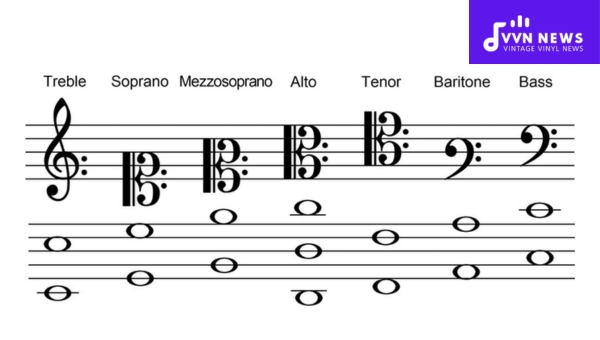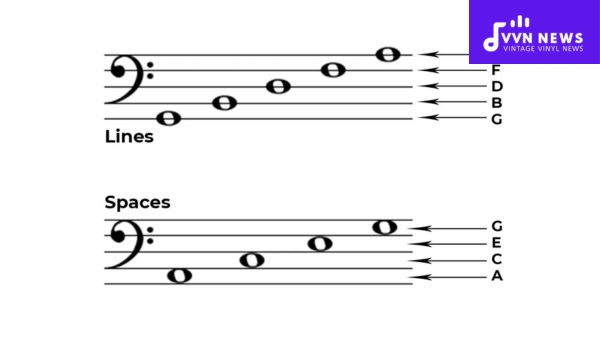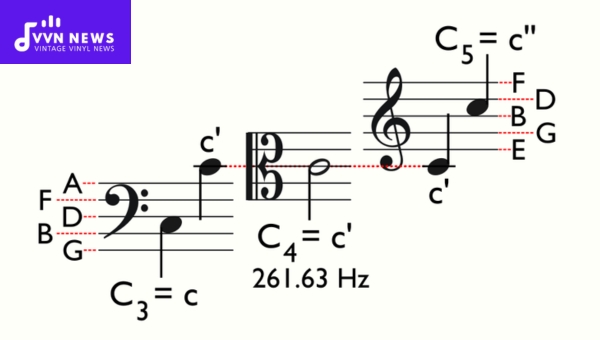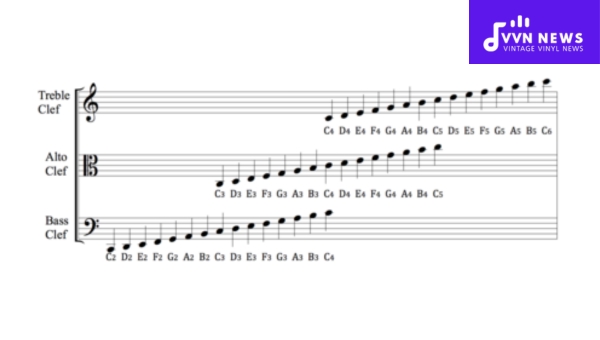Music, a world filled with harmonious enchantments, a universal language that traverses borders, can often come across as complicated. Fret not about the complexity, because I’m here with the ultimate guide to clefs in music – your key to uncovering more of this captivating universe.
This guide will help you delve deeper into the intricate art of reading music. Many are fascinated by the melodies that waft from the piano or violin but balk at the cryptic symbols on a piece of music sheet.
Unknown to many, these symbols known as clefs hold immense significance and are instrumental in every melody rendered. My goal throughout this guide is to make these complex ciphers as clear as a beautiful symphony.
What Are Clefs in Music?
In music, clefs are integral symbols used to define the pitch of the notes placed on one of the lines on a stave, or music bar. Essentially, a clef calibrates or sets the tonal ‘benchmark’ for other notes on a sheet of music.
There are three primary types: Treble, Bass, and C Major, also referred to as Alto or Tenor Clef. Each variety provides direction on how to interpret the other symbols found on the score.
Thus, they play an essential role in reading and interpreting sheet music effectively. As you dive deeper into this fascinating musical universe, learning about these unique symbols will be invaluable along your journey.
Also Read: Phrygian Mode [Adding Exotic Flair To Your Musical Compositions]
How Do Clefs Affect Musical Notation?
Clefs play a pivotal role in music notation. They function as a reference point, indicating the pitch of the written notes. Here is how they leave an indelible mark on musical notation:

- Defining Musical Staff: Clefs assist in the definition of musical staffs, which are five horizontal lines where notes are placed. Each line and space represents a different pitch, which is determined by the clef.
- Indicating Pitch: A clef is positioned at the beginning of each staff to denote the range and specific pitches of the notes on that staff. Therefore, changing a clef effectively alters all subsequent notes.
- Bass and Treble Clef Impact: Known for their unique designations, Bass and Treble clefs directly impact which notes are denoted by lines and spaces on a musical staff. The line signified by ‘F’ (bass clef) or ‘G’ (treble clef) anchors every other note to its relative position.
- Usage across Instruments: Clefs play a role not only in reading music but also in various instruments. The selection of the clef often depends on the tessitura (voice or instrument’s most comfortable range). For instance, piano notation typically includes both bass and treble clefs, while violin music predominantly uses a treble clef.
- Influence Score Appearance: Changing from one type of Clef to another dramatically impacts how scores will look because it affects the vertical placement of notes on staves – for example, switching from treble to bass moves every note down one tone or two semitones.
These elements demonstrate how instrumental clefs are to musical notation.
They serve not only as system symbols but guide musicians into intricate world symphonies that otherwise would be impossible to traverse without them.
They are indeed a critical element of music, presenting the pitch and quality of sounds in a format that’s easy for musicians to follow.
Also Read: E Minor Pentatonic Scale [How To Use In Your Music Composition]
What Are the Different Types of Clefs?
Music is full of symbols that instruct musicians on how to play a piece of music, with clefs being among the most fundamental.
Each clef marks a specific pitch range on the staff, indicating where notes are situated.
As you delve into reading music, grasping these symbols will greatly enhance your abilities to interpret and perform compositions accurately.
Treble Clef
Also known as the G clef, the treble clef spirals around the second line from the bottom of the staff, designating this line as G above middle C.
Standard for high-pitched instruments like the flute, violin, and trumpet, it also reigns over women’s and children’s vocal music.
The beauty of treble clef lies in its focus on notes that typically soar above middle C.
Bass Clef
In contrast to its higher counterpart, the bass clef, or F clef, fixates on lower pitches.
With two dots placed snugly around the fourth line from the bottom of the staff (identifying it as F below middle C), it’s chiefly used for lower-pitched instruments like bassoon, cello, and tuba, as well as for baritone and bass voices.
Its domain is primarily built around notes that plunge below middle C.
The Grand Stave
A powerful combination emerges when you intertwine treble and bass clefs to form the grand stave.
This tool is essential for keyboard instruments like piano and harp where both hands navigate separate pitch ranges simultaneously.
Essentially two staves linked together by a brace on their left side show an expanse of pitches that encompass both trebles and bass territories.
Alto Clef
Slightly less familiar but equally indispensable in certain contexts is the alto clef or C clef.
It positions middle C on its center line—this is third from top or bottom—and it’s primarily used within viola music sheets since viola repertoire comfortably nestles within this mid-range spectrum.
Tenor Clef
Adjacent in function to alto is tenor clef, another manifestation of C clef which situates middle C a tad higher onto the fourth line from the bottom up—a perfect fit for upper ranges of trombones or cellos when their parts vault into higher pitch territories usually notated in bass clef.
Recognizing each one bestows upon performers a versatile skillset allowing them to navigate through diverse musical landscapes with ease.
Mastery of these symbols equates to unlocking realms of harmony across genres extending from classical masterpieces to contemporary scores.
Also Read: 17 Best Patchbay For Studio & Live Audio [Organize Your Gear]
How Does the Bass Clef Define Lower Notes?
The Bass Clef, also known as the F clef, is a critical symbol in music notation that signifies lower musical pitches.

On sheet music, it appears as an ornate symbol with two dots on either side of the fourth line of the staff—the line that represents the note F below middle C.
In reading music meant for instruments like the cello, bass guitar, and tuba, you will primarily encounter this clef.
Its role is to anchor these tones and provide musicians with a clear framework for deep resonances.
When you see the Bass Clef on a stave, immediate recognition tells you that the notes will range within a particular register—generally lower tones resonant with depth and warmth.
Each line and space correspond to specific pitches starting from E just below the staff lines (on what’s called a ledger line), ascending through G, B, D, and then F upon hitting that pivotal fourth line defined by those two strategically placed dots. Similarly, the spaces denote A, C, E, and G – from bottom to top.
This distinct clef unlocks an entire spectrum of sonic depths that might otherwise remain untapped.
For bass vocalists or players of lower-pitched instruments, mastering this symbol profoundly impacts their ability to accurately interpret deeper melodies woven into every piece they perform.
Also Read: E Major Triad [Master This Staple Of Music Composition]
What Is the Purpose of the Alto and Tenor Clefs?
The alto and tenor clefs occupy a specialized niche in musical notation.
Referred to as C clefs, their principal function is to pinpoint the middle C on the staff, which differs from the treble and bass clefs defining higher and lower note ranges, respectively.
Identifying Middle C
The alto clef — sometimes known as the viola clef — positions middle C on the third line of the staff.
Similarly, the tenor clef places it on the fourth line. This central placement aligns with vocal and instrumental ranges that straddle a median pitch territory.
Usage in Ensembles
Primarily, these two clefs are significant for musicians playing instruments such as the viola, cello (in tenor register), and trombone.
The usage is also prevalent within vocal scores for altos or tenors, offering a tailored reading experience that limits ledger lines for better legibility.
Optimizing Legibility
By opting for an alto or tenor clef over excessive ledger lines, composers ensure a cleaner look that facilitates swift recognition of notes.
This advantage simplifies sight-reading and allows performers to focus more on expression than decoding a forest of lines above or below the staves.
Each appearance of an alto or tenor clef beckons musicians with its promise: here lies a clear path through music’s lush but often complex terrain of pitch documentation.
What Are the Historical Origins of Clefs?
The clef, an essential notational element, dates back to the 9th century. Its birth is closely tied to Guido of Arezzo, a pivotal medieval music theorist.

He transformed music practice with the “Guidonian hand,” a memory aid for note positions. Initially, only the F and C clefs existed, with the G clef arriving later in the 16th century.
The evolution continued as these symbols found their settled form and fixed positions on the stave during the Baroque period, becoming indispensable in transcribing music’s pitch accurately for diverse vocal ranges and instruments.
Also Read: A Sharp Minor Pentatonic Scale [Unique Harmonic Possibilities]
How Do Clefs Vary Across Different Instruments?
The world of music is a vast expanse where clefs represent not only the pitches of notes but also the idiosyncratic range of various instruments.
Be it strings, brass, woodwinds, or keyboards, each family of instruments interacts uniquely with these musical symbols.
Piano and Keyboard Instruments
In piano music, the grand staff combines both treble and bass clefs, laid out side-by-side.
The right hand typically plays notes in the treble clef while the left hand navigates through the bass clef notes. This dual setup caters perfectly to the wide range of pianos possess.
String Instruments
String instruments like violins exclusively utilize the treble clef due to their higher pitch repertoire.
Conversely, the cello and double bass often see utilization of bass clef.
Yet, instruments like viola stand apart by employing the alto clef primarily because their range sits snugly in its design, avoiding ledger lines for enhanced readability.
Woodwind and Brass Instruments
Woodwinds such as clarinets adapt to treble clef whereas bassoons often resort to bass clef for their lower tones.
Brass instruments display a mixture; trumpets align with treble, whereas trombones and tubas can swing between both depending on their part in a composition.
Vocal Music
When it comes to vocal music, different voice types—soprano, alto, tenor, or bass—traditionally align with suitable clefs.
These adaptations ensure that each vocal range avoids cluttered staves filled with ledger lines which could greatly hinder legibility during performance.
A fascinating aspect is that certain instruments might switch between clefs within a single piece—this reflects dynamic changes dictated by a musical score.
The tenor trombone serves as an excellent illustration: it moves between tenor and bass clefs according to its passage’s pitch range demands.
It’s crucial for musicians playing transposing instruments—like B♭ trumpet—to realize that while they read treble clef, their instrument demands mental transposition to produce correct concert pitches.
Clefs are not solely pitch-related symbols—they are tailored navigational tools designed for specific instrument ranges ensuring clarity and fluency in music reading irrespective of instrumental diversity.
\Also Read: Transposition Chart [A Lifesaver For All Musicians]
FAQs
What is the most common clef used in music?
The most common clef is the treble clef, which is primarily used for higher-pitched instruments and voices.
Do I need to learn all clefs to read music?
While it’s beneficial, you don’t need to know all the clefs. Focus on the clef(s) relevant to your instrument or vocal range.
Can a piece of music change clefs?
Yes, pieces can and often do change clefs; this is known as a clef change, signaling different pitch ranges are coming into play.
Are there any instruments that use multiple clefs?
Yes, instruments like the piano use both treble and bass clefs simultaneously, which is why pianists must be proficient in reading both.
How does a C clef indicate pitch?
The C clef positions middle C on the staff and can move between alto and tenor positions to adjust for vocal or instrumental range.
Also Read: A Guide Transposing Into The Alto C [Navigate Music Transposition]
Conclusion
Clefs are the cornerstone of music notation, laying the groundwork for note placement on the staff.
In mastering them, you lift the veil of complexity from sheet music, allowing for a fuller appreciation and precise interpretation of musical compositions.
The role of treble, bass, alto, and tenor clefs gives you the versatility to navigate multiple instruments and genres with ease.
Always remember that each clef is an invitation to a distinct sonic realm. So embrace them and watch your musical literacy flourish.








